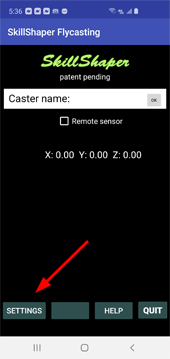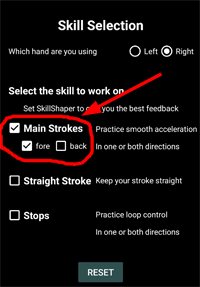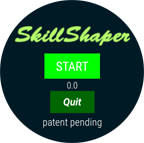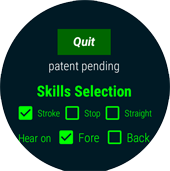
cell (914) 572-0454
email lang@SkillShaper.com
Learn Fly Casting Skills
The Strokes:
The most important movement skill in fly casting is the stroke of the forward cast. Although you can tell your brain that fly casting strokes need to: “start slow, accelerate smoothly and come to a crisp stop” your muscles will be no closer to being able to do it than they were before. Words don’t give them the feel of the movement they need to perform. But sound patterns can – which is what SkillShaper gives you.
Building muscle memory
There is no caster who can’t benefit from practicing their stroke moves with SkillShaper feedback. One way drills are a useful way to build the correct muscle memory. You can do them by casting with rod-and-line if you have SkillShaper on a smart watch, or by air casting with a phone: gripping it like a fly rod and pantomiming your cast. Both are great ways to build muscle memory.
One-way drills
Set up the app to play sound only for acceleration in the forward direction (See the side panel)
If you are line-casting (holding a watch against the rod), lay a length of line out straight behind you. Two or three rod lengths will do for a start.
If you are air-casting (without a rod) hold your hand up and back as if you were about to start a forward cast.
Then do a forward stroke.
Start slow - this straightens out the line and gets
it pointing in the right direction:
"uhhh"
Accelerate smoothly: faster and faster as you
accelerate smoothly.
"uu-aaa-eeeee”
The line flies forward.
Stop crisply and freeze:
"pu"
Now hold your position right where it was at the stop. This part is
critical.
The line will straighten out in the air, stop and drift to the ground.
Now turn around so the line is behind you and repeat.
Do this over and over until you are making this sound on every cast
without thinking about it.
"uhhuuuaaaeeeeePu"
Back Cast Stroke. Do the same drill with a back stroke - set the app to make sound on backwards movement. Start with the line laid out in front of you and stroking it backwards. Again, watch what it is doing, and looking to make the same rising sound: slow, smooth acceleration, to a crisp stop.
Turn and repeat.
Now that you have that sound of a good forward stroke in your ear, it will
take you a lot less time to get this back stroke one going right.
Connect the strokes
Once your muscles know the effort pattern of
one-way strokes, link
the Back and Forward strokes together.
Set the app to play sound in
both the Fore and Back directions
Start with a back cast, but
just before your line has completely uncurled behind you, start a
forward cast: slow at first and then accelerate smoothly into a
crisp stop.
Keep watching the line: first
as you fly it back, then pause while it starts uncurling after the
stop, and then drive it forward.
Focus on the timing: the
length of your pause is critical. You need to start the forward
stroke at just the right time. Your line’s flight will let you know:
way too soon and you will not be able to drive your foreward cast,
and if you start too late your back cast will drop and may
catch the ground or a bush behind you.
Stopping the stroke
A critical skill. Stops are the secret to loop control – and loop control is the secret to longer casts.
Set the app to the Stops movement skill and the Fore direction. You will only hear sound at the the end of the stroke: when you stop its forward motion.
Do the cast: a regular forward cast, with a stop at
the end of the stroke.
Listen to the sound: The pitch
reflects how quickly you stopped:
Crisper stops make higher pitched sounds
Crisper stops also make for tighter loops.
So practice making high pitch stops.
Keep doing them until you hear that pitch every time
Staying in a straight line
Moving things in a straight line is unnatural
for the human body. Joints move in arcs, not straight lines, with
the result that the rod tip (driven by legs, hips, shoulders, elbows
and wrists) ends up swerving from one side to the other during a
stroke. Learn to control this with SkillShaper’s “Straight Line”
skill setting. It will make a sound when the path of your stroke
veers off the straight – the more you veer, the higher pitch the
sound will be.
The reason it matters. When a
cast stroke is not straight, it wastes energy with the result that
line speed is reduced, distance is limited, accuracy is sacrificed
and you tire out sooner. Not good.
Build the muscle memory. Practice straight line
casting with overhead casts. Then with side arm casts. Then while
facing the target straight on, then facing sideways. Shape the
muscle memory of straight-line movement until it starts feeling
normal to you.
When the straight-line stroke becomes
instinctive, your casts will become faster, longer, more accurate
and easier. It is worth
working on.
Settings on the Phone app
From the start page
Tap the Settings button

This takes you to the Skill Selection psge.
On the Skill Selection page Main Stroke and Fore are selected as defaults.

Change them as you wish.
For sound on the back stroke, uncheck "fore" an check "back"
For sound in both directions, check both "fore" and "back"
For other skills, check their boxes. Only one skill can be checked at a time.
Settings on the Watch app
Scroll down on the app screen.

Select the movement skill and the direction from the options displayed.
